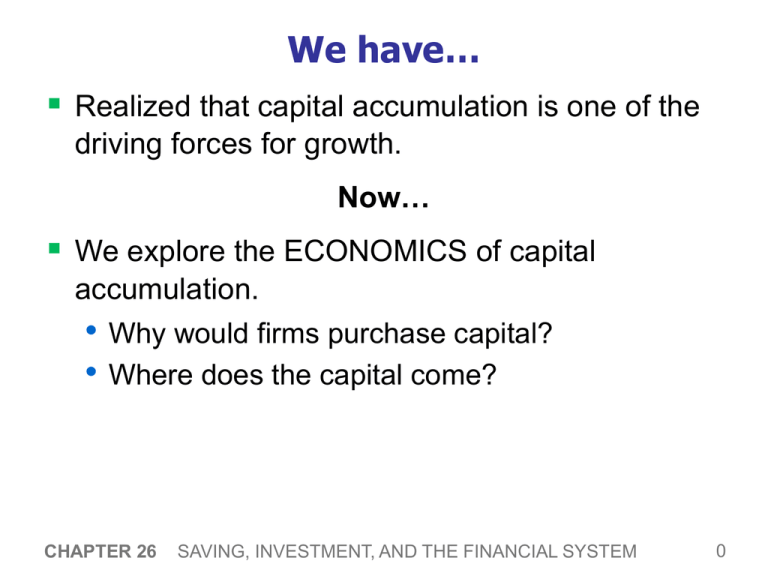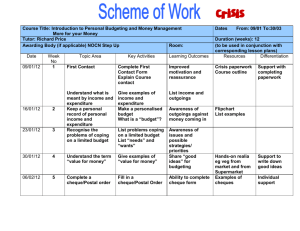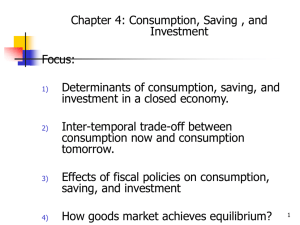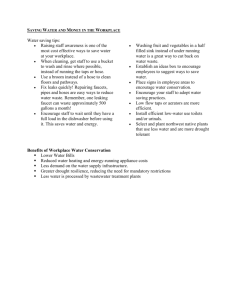
We have…
Realized that capital accumulation is one of the
driving forces for growth.
Now…
We explore the ECONOMICS of capital
accumulation.
• Why would firms purchase capital?
• Where does the capital come?
CHAPTER 26
SAVING, INVESTMENT, AND THE FINANCIAL SYSTEM
0
This coming Thursday, 1st Midterm
Preparations:
• Ink pens
• Non-programmable calculator
• Picture ID.
• 1 hour and 10 minutes.
• Regular lecture time and lecture room.
• scantron form
Key materials:
• GDP: product approach, income approach, and
•
expenditure approach;
Growth and Social Security Reform
CHAPTER 26
SAVING, INVESTMENT, AND THE FINANCIAL SYSTEM
1
26
Saving, Investment, and the
Financial System
PRINCIPLES OF
ECONOMICS
FOURTH EDITION
N. G R E G O R Y M A N K I W
PowerPoint® Slides
by Ron Cronovich
© 2007 Thomson South-Western, all rights reserved
In this chapter, look for the answers to
these questions:
What are the main types of financial institutions
in the U.S. economy, and what is their function?
What are the three kinds of saving?
What’s the difference between saving and
investment?
How does the financial system coordinate saving
and investment?
How do govt policies affect saving, investment,
and the interest rate?
CHAPTER 26
SAVING, INVESTMENT, AND THE FINANCIAL SYSTEM
3
Robinson-Crusoe Economy Again…
CHAPTER 26
SAVING, INVESTMENT, AND THE FINANCIAL SYSTEM
4
Saving of Robinson
Why will Robinson save?
• He may get sick one day; (save for
•
•
unemployment)
He may need a break the next day; (save for
vacation)
He plans to make fishnets the next day to
catch more fishes in the future. (save for
investment).
Suppose that fish is storable…
Suppose that fish is non-storable…
CHAPTER 26
SAVING, INVESTMENT, AND THE FINANCIAL SYSTEM
5
Yes, he can; but not alone
Suppose there are two Robinsons.
Robinson 1
CHAPTER 26
Robinson 2
SAVING, INVESTMENT, AND THE FINANCIAL SYSTEM
6
Two Robinsons can make arrangement
Robinson 1 gets sick one day and cannot catch
fish.
Robinson 2 helps him out by sharing fish with
him
But Robinson 1 makes the promise that he will
return the fish back once he recovers and fishes
again.
In this case, Robinson 1 is the borrower and
Robinson 2 is the saver.
The income of the saver goes to the borrower.
CHAPTER 26
SAVING, INVESTMENT, AND THE FINANCIAL SYSTEM
7
Two Robinsons can make another
arrangement…
Robinson 1 wants to spend a day making
fishnets to catch more fish in the future;
Robinson 2 helps Robinson 1 by sharing fish
with him; Robinson 1 promises that he will give
the fish back.
In this case, Robinson 2 is still the saver, but
Robinson 1 is the investor.
The investment is financed by saving.
CHAPTER 26
SAVING, INVESTMENT, AND THE FINANCIAL SYSTEM
8
When there are only two Robinsons
They talk and make arrangement;
When there are millions of people as
in the real world…
Things take place through MARKET;
In this case, firms’ investment are financed by
households’ saving through FINANCIAL
MARKETS or FINANCIAL INTERMEDIARIES –
together they constitute financial system
CHAPTER 26
SAVING, INVESTMENT, AND THE FINANCIAL SYSTEM
9
Financial Institutions
The financial system: the group of
institutions that helps match the saving of
one person with the investment of another.
• Direct interaction – Financial Markets
(bonds market, stock market)
• Indirect interaction – Financial
Intermediaries. (banks, mutual funds)
CHAPTER 26
SAVING, INVESTMENT, AND THE FINANCIAL SYSTEM
10
Direct interaction between savors and
borrowers
Financial markets: institutions through
which savers can directly provide funds to
borrowers. Examples:
• The Bond Market.
A bond is a certificate of indebtedness.
• The Stock Market.
A stock is a claim to partial ownership in
a firm.
CHAPTER 26
SAVING, INVESTMENT, AND THE FINANCIAL SYSTEM
11
The Stock Market
Partial ownership by funding the purchase of
capital;
Declares share of the corporate profits;
Stocks are riskier than bonds, why?
• Bond represents a firm’s obligation to pay the
•
•
money back.
Investors take the risks themselves by
purchasing the partial ownership.
Before a firm goes bankrupt, its remaining
assets are used first to pay off the debts.
CHAPTER 26
SAVING, INVESTMENT, AND THE FINANCIAL SYSTEM
14
Stock Exchange
Once stocks are issued, they change owners via
the stock exchange market.
• NY Stock Exchange
• American Stock Exchange
• NASDAQ
Stock price of a firm depends on
• The firms’ profitability
• People’s perception for the firms’ future.
CHAPTER 26
SAVING, INVESTMENT, AND THE FINANCIAL SYSTEM
15
1929 Crash of the NY Stock Exchange
during the Great Depression
CHAPTER 26
SAVING, INVESTMENT, AND THE FINANCIAL SYSTEM
16
NASDAQ: the world’s biggest electronic
stock exchange system
CHAPTER 26
SAVING, INVESTMENT, AND THE FINANCIAL SYSTEM
17
Stock Price Indexes
Just like GDP deflator is the average price for all
goods and services produced in the US;
Stock price indexes is the average price of
different companies’ stock prices.
Depending on which companies’ stock price is
included, we have:
• Dow Jones Industrial Average: 30 major US
companies such as GM, AT&T…
• Standard&Poor’s 500 Index: 500 major
companies.
CHAPTER 26
SAVING, INVESTMENT, AND THE FINANCIAL SYSTEM
18
Financial Institutions
Financial intermediaries: institutions through
which savers can indirectly provide funds to
borrowers. Examples:
• Banks that take deposits from the households
and make loans to firms.
• Mutual funds – institutions pool savings from
the public that is invested and managed on their
behalf by professional money managers.
CHAPTER 26
SAVING, INVESTMENT, AND THE FINANCIAL SYSTEM
19
Mutual Funds
CHAPTER 26
SAVING, INVESTMENT, AND THE FINANCIAL SYSTEM
20
Different Kinds of Saving
Private saving
= The portion of households’ income that is
not used for consumption or paying taxes
=Y–T–C
Public saving
= Tax revenue less government spending
=T–G
CHAPTER 26
SAVING, INVESTMENT, AND THE FINANCIAL SYSTEM
21
National Saving
National saving
= private saving + public saving
=
(Y – T – C) +
=
(T – G)
Y – C – G
= the portion of national income that is not used
for consumption or government purchases
CHAPTER 26
SAVING, INVESTMENT, AND THE FINANCIAL SYSTEM
22
Saving and Investment
Recall the national income accounting identity:
Y = C + I + G + NX (-5.8%)
For the rest of this chapter, focus on the closed
economy case:
Y=C+I+G
Solve for I:
I = Y–C–G
national saving
= (Y – T – C) + (T – G)
Saving = investment in a closed economy
CHAPTER 26
SAVING, INVESTMENT, AND THE FINANCIAL SYSTEM
23
Budget Deficits and Surpluses
Budget surplus
= an excess of tax revenue over govt spending
= T–G
= public saving
Budget deficit
= a shortfall of tax revenue from govt spending
= G–T
= – (public saving)
CHAPTER 26
SAVING, INVESTMENT, AND THE FINANCIAL SYSTEM
24
ACTIVE LEARNING
Exercise
1:
Suppose GDP equals $10 trillion,
consumption equals $6.5 trillion,
the government spends $2 trillion
and has a budget deficit of $300 billion.
Find public saving, taxes, private saving,
national saving, and investment.
25
ACTIVE LEARNING
Answers
Given:
Y = 10.0,
C = 6.5,
1:
G = 2.0,
G – T = 0.3
Public saving = T – G = – 0.3
Taxes: T = G – 0.3 = 1.7
Private saving = Y – T – C = 10 – 1.7 – 6.5 = 1.8
National saving = Y – C – G = 10 – 6.5 = 2 = 1.5
Investment = national saving = 1.5
26
ACTIVE LEARNING
Exercise
1B:
Now suppose the government cuts taxes by
$200 billion.
In each of the following two scenarios,
determine what happens to public saving,
private saving, national saving, and investment.
1. Consumers save the full proceeds of the
tax cut.
2. Consumers save 1/4 of the tax cut and
spend the other 3/4.
27
ACTIVE LEARNING
Answers
1B:
In both scenarios, public saving falls by
$200 billion, and the budget deficit rises
from $300 billion to $500 billion.
1. If consumers save the full $200 billion,
national saving is unchanged,
so investment is unchanged.
2. If consumers save $50 billion and spend
$150 billion, then national saving and
investment each fall by $150 billion.
28
ACTIVE LEARNING
Discussion questions
1C:
The two scenarios are:
1. Consumers save the full proceeds of the
tax cut.
2. Consumers save 1/4 of the tax cut and
spend the other 3/4.
Which of these two scenarios do you think is the
most realistic?
Why is this question important?
29
The Meaning of Saving and Investment
Private saving is the income remaining after
households pay their taxes and pay for
consumption.
Examples of what households do with saving:
• buy corporate bonds or equities
• purchase a certificate of deposit at the bank
• buy shares of a mutual fund
• let accumulate in saving or checking accounts
CHAPTER 26
SAVING, INVESTMENT, AND THE FINANCIAL SYSTEM
30
The Meaning of Saving and Investment
Investment is the purchase of new capital.
Examples of investment:
• General Motors spends $250 million to build
a new factory in Flint, Michigan.
• You buy $5000 worth of computer equipment
for your business.
• Your parents spend $300,000 to have a new
house built.
Remember: In economics, investment is NOT
the purchase of stocks and bonds!
CHAPTER 26
SAVING, INVESTMENT, AND THE FINANCIAL SYSTEM
31
The Market for Loanable Funds
A supply-demand model of the financial system.
Helps us understand
• how the financial system coordinates
saving & investment
• how govt policies and other factors affect
saving, investment, the interest rate
CHAPTER 26
SAVING, INVESTMENT, AND THE FINANCIAL SYSTEM
32
The Market for Loanable Funds
Assume: only one financial market.
• All savers deposit their saving in this market.
• All borrowers take out loans from this market.
• There is one interest rate, which is both the
return to saving and the cost of borrowing.
CHAPTER 26
SAVING, INVESTMENT, AND THE FINANCIAL SYSTEM
33
The Market for Loanable Funds
The supply of loanable funds comes from saving:
• Households with extra income can loan it out
and earn interest.
• Public saving, if positive, adds to national
saving and the supply of loanable funds.
If negative, it reduces national saving and the
supply of loanable funds.
CHAPTER 26
SAVING, INVESTMENT, AND THE FINANCIAL SYSTEM
34
The Slope of the Supply Curve
Interest
Rate
Supply
6%
3%
60
CHAPTER 26
80
An increase in
the interest rate
makes saving
more attractive,
which increases
the quantity of
loanable funds
supplied.
Loanable Funds
($billions)
SAVING, INVESTMENT, AND THE FINANCIAL SYSTEM
35
The Market for Loanable Funds
The demand for loanable funds comes from
investment:
• Firms borrow the funds they need to pay for
new equipment, factories, etc.
• Households borrow the funds they need to
purchase new houses.
CHAPTER 26
SAVING, INVESTMENT, AND THE FINANCIAL SYSTEM
36
The Slope of the Demand Curve
A fall in the interest
rate reduces the cost
of borrowing, which
increases the quantity
of loanable funds
demanded.
Interest
Rate
7%
4%
Demand
50
80 Loanable Funds
($billions)
CHAPTER 26
SAVING, INVESTMENT, AND THE FINANCIAL SYSTEM
37
Equilibrium
Interest
Rate
Supply
The interest rate
adjusts to equate
supply and demand.
The eq’m quantity
of L.F. equals
eq’m investment
and eq’m saving.
5%
Demand
60
CHAPTER 26
Loanable Funds
($billions)
SAVING, INVESTMENT, AND THE FINANCIAL SYSTEM
38
Policy 1: Saving Incentives
Interest
Rate
S1
S2
5%
4%
D1
60 70
CHAPTER 26
Tax incentives for
saving increase
the supply of L.F.
…which reduces the
eq’m interest rate
and increases the
eq’m quantity of L.F.
Loanable Funds
($billions)
SAVING, INVESTMENT, AND THE FINANCIAL SYSTEM
39
Policy 2: Investment Incentives
Interest
Rate
An investment tax
credit increases the
demand for L.F.
S1
6%
5%
D2
…which raises the
eq’m interest rate
and increases the
eq’m quantity of L.F.
D1
60 70
CHAPTER 26
Loanable Funds
($billions)
SAVING, INVESTMENT, AND THE FINANCIAL SYSTEM
40
Policy 3: Govt Budget Deficits
Interest
Rate
S2
S1
A budget deficit reduces
national saving and the
supply of L.F.
6%
5%
D1
50 60
CHAPTER 26
…which increases
the eq’m interest rate
and decreases the
eq’m quantity of L.F.
Loanable Funds
($billions)
SAVING, INVESTMENT, AND THE FINANCIAL SYSTEM
41
ACTIVE LEARNING
Exercise
2:
Use the loanable funds model to analyze
the effects of a government budget deficit:
•
Draw the diagram showing the initial
equilibrium.
•
Determine which curve shifts when the
government runs a budget deficit.
•
•
Draw the new curve on your diagram.
What happens to the equilibrium values of the
interest rate and investment?
42
ACTIVE LEARNING
Answers
Interest
Rate
S2
S1
2:
A budget deficit reduces
national saving and the
supply of L.F.
…which increases
the eq’m interest rate
and decreases the
eq’m quantity of L.F.
and investment.
6%
5%
D1
50 60
Loanable Funds
($billions)
43
Budget Deficits, Crowding Out,
and Long-Run Growth
Our analysis: increase in budget deficit causes
fall in investment.
The govt borrows to finance its deficit,
leaving less funds available for investment.
This is called crowding out.
Recall from the preceding chapter: Investment
is important for long-run economic growth.
Hence, budget deficits reduce the economy’s
growth rate and future standard of living.
CHAPTER 26
SAVING, INVESTMENT, AND THE FINANCIAL SYSTEM
44
The U.S. Government Debt
The government finances deficits by borrowing
(selling government bonds).
Persistent deficits lead to a rising govt debt.
The ratio of govt debt to GDP is a useful
measure of the government’s indebtedness
relative to its ability to raise tax revenue.
Historically, the debt-GDP ratio usually rises
during wartime and falls during peacetime – until
the early 1980s.
CHAPTER 26
SAVING, INVESTMENT, AND THE FINANCIAL SYSTEM
45
U.S. Government Debt
as a Percentage of GDP, 1970-2005
120%
WW2
100%
80%
60%
40%
Revolutionary
War
Civil
War
WW1
20%
0%
1790 1810 1830 1850 1870 1890 1910 1930 1950 1970 1990 2010
CONCLUSION
Like many other markets, financial markets are
governed by the forces of supply and demand.
One of the Ten Principles from Chapter 1:
Markets are usually a good way
to organize economic activity.
Financial markets help allocate the economy’s
scarce resources to their most efficient uses.
Financial markets also link the present to the future:
They enable savers to convert current income into
future purchasing power, and borrowers to acquire
capital to produce goods and services in the future.
CHAPTER 26
SAVING, INVESTMENT, AND THE FINANCIAL SYSTEM
47
CHAPTER SUMMARY
The U.S. financial system is made up of many
types of financial institutions, like the stock and
bond markets, banks, and mutual funds.
National saving equals private saving plus
public saving.
In a closed economy, national saving equals
investment. The financial system makes this
happen.
CHAPTER 26
SAVING, INVESTMENT, AND THE FINANCIAL SYSTEM
48
CHAPTER SUMMARY
The supply of loanable funds comes from saving.
The demand for funds comes from investment.
The interest rate adjusts to balance supply and
demand in the loanable funds market.
A government budget deficit is negative public
saving, so it reduces national saving, the supply of
funds available to finance investment.
When a budget deficit crowds out investment,
it reduces the growth of productivity and GDP.
CHAPTER 26
SAVING, INVESTMENT, AND THE FINANCIAL SYSTEM
49






